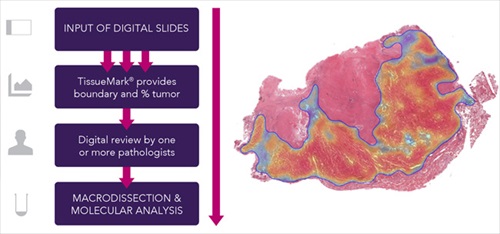Members Login

Channels
Special Offers & Promotions
British technology could be biggest breakthrough in cancer treatment
New Technology Could Be The Greatest Breakthrough In Cancer Treatment
- TissueMark software automatically marks and detects potentially cancerous sections in tissue samples with unprecedented levels of speed and accuracy
- Technology has the potential to save pathologists a combined 250,000 working days of effort per annum
- Leap in precision equates to the shift from a freehand outline sketch of a country’s border to a high resolution map of the whole country
New technology, developed in Belfast, will soon enable pathologists to automate the process of marking tissue samples with unprecedented accuracy.
TissueMark, developed by digital pathology specialists PathXL, analyses the detailed structural patterns in tissue samples and marks the boundaries of potentially cancerous sections for more detailed analysis. The new software will help accelerate cancer research and discovery, reduce time in drug development and to identify new markers of the disease.
To date, this process has been carried out manually, with sections being hand-marked by pathologists on slides. An expert pathologist can mark around one hundred samples per day. TissueMark can do the same work in greater detail in ten minutes.
A study in the Journal of the American Medical Association found that adverse drug reactions were the fourth biggest killer in the US, behind heart disease, cancer and strokes. TissueMark will play a part in the acceleration of the development of personalized medicine and customized drugs.
Currently an estimated 25 million tissue samples are analysed annually. Based on these volumes TissueMark has the potential to save pathologists a combined 250,000 working days of effort per annum and complete the same work with pinpoint accuracy in one fiftieth of the time.
TissueMark’s accuracy, combined with huge increases in the speed of processing, opens the gateway to faster and more accurate diagnoses and the development of treatments. By truncating the diagnostic process and marking slides with a level of precision that cannot be achieved in manual intervention, TissueMark’s developers believe that there is a real prospect of faster drug discovery and better treatment outcomes. TissueMark analysis can be carried out remotely and cross-border, enabling more effective collaboration between centers of excellence.
Des Speed, chief executive of PathXL, said: “Manual marking is a relatively slow process that can create significant backlogs. By removing the bottleneck and delivering greater levels of accuracy we can help accelerate drug development, and the detection and analysis of cancerous tissue.”
Dr Scott Binder, Senior Vice Chair and Director of Pathology Clinical Services at the Department of Pathology & Laboratory Medicine at the University of California at Los Angeles (UCLA), said: “I welcome the development of this new TissueMark technology which will bring new levels of efficiency and accuracy to tissue annotation, freeing pathology professionals worldwide to focus their time and expertise on their most important work, the accurate and timely diagnosis of tumors and other disorders.”
Pathology services worldwide are widely acknowledged to be in short supply. In some countries there are a handful of pathologists to serve the entire population. One African country, reputedly, has only one fully qualified pathologist to serve the entire population. By freeing pathologists of responsibility for marking slides, TissueMark enables these experts to apply their expertise to the next and crucial stage of diagnosis, leading to faster and more accurately prescribed treatments.
The leap in sophistication and accuracy that TissueMark enables has been described by scientists as being the equivalent of the shift from a freehand outline sketch of a country’s border to a high resolution map of the whole country.
PathXL consulted leading molecular pathologists during the development of TissueMark. All emphasised that for most molecular assays, such as PCR, it is critical to separate tumor from non-tumor tissue to ensure accurate results. TissueMark is built with this capability. As the number of molecular tests increase and the options for patients become more intricate, TissueMark’s speed and reliability will become essential.
Dr James Eshleman, Professor of Pathology and Oncology, Associate Director, Molecular Diagnostics Laboratory, Johns Hopkins University School of Medicine, said: "Tissue annotation for subsequent molecular analysis is very important in modern molecular diagnostic laboratories."
TissueMark’s first release is built to check for the potential presence of lung, colorectal and breast cancers. Work is near completion on additional software modules to check for the possible presence of several other forms of cancer, including ovarian and prostate cancer. The software will be compatible with all major scanning technologies.
Des Speed added: “It is now widely accepted that identifying the molecular signature in individual tumours is vital to the development and selection of targeted therapies. Technologies, such as TissueMark, are now emerging that enable scientists to achieve this. Equipping pathologists with our technology will lead to faster, better diagnosis and the potential to make significant savings in time and resource at a time when the burden on medical services is rising rapidly.”
Media Partners



